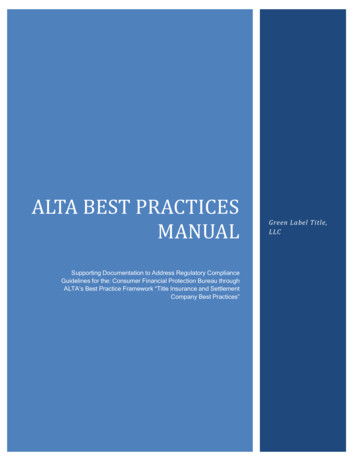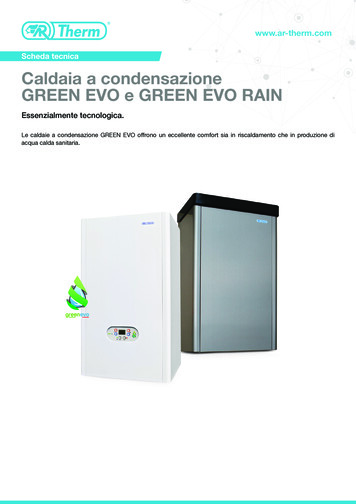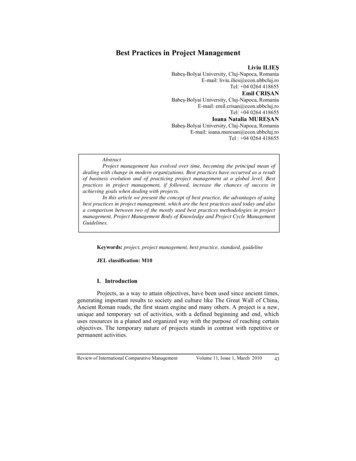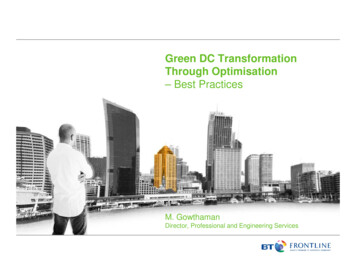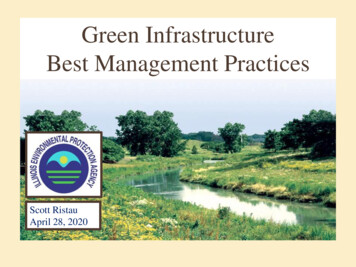
Transcription
Green InfrastructureBest Management PracticesScott RistauApril 28, 2020
Urban Stormwater Runoff Much of the land surface in urban and suburban areas is covered bybuildings, pavement, and compacted terrain that do not allow rain andsnowmelt to soak into the ground. These impervious surfaces greatly increase the volume and velocity ofstormwater runoff. As it flows over urban land surfaces, stormwater runoff also picks uppollutants that can adversely affect water quality if discharged untreatedinto lakes or streams.
Urban stormwater runoff is amajor nonpoint source of waterpollution in Illinois. Runoff in urban areas oftencontains nitrogen, phosphorus,total suspended solids,sediment, pesticides, motor oil,road salt, household chemicals,and bacteria.
Gray stormwater infrastructure (i.e., conventional piped drainage) isdesigned to move urban stormwater away from the built environment.Green infrastructure reduces stormwater flows to storm sewer systems orto surface waters while also delivering other environmental benefits, suchas nonpoint source pollution control.
Green InfrastructureGreen Infrastructure is any stormwater management technique orpractice employed to capture, filter, or reduce runoff while alsopreserving, restoring, mimicking, or enhancing natural hydrology.Green Infrastructure includes: methods of using soil and vegetation to promote percolation,evapotranspiration, and filtration; the preservation and restoration of natural landscape features, such asforests, floodplains, headwaters, and wetlands; and rainwater harvesting for non-potable uses, such as toilet flushing andlandscape irrigation.
Green Infrastructure Practices Are designed to meet multiple stormwater management objectives, includingrunoff volume reduction and water quality protection. Can be constructed individually, or as part of a larger scale approach. Should be part of a decentralized management strategy that uses multiplelocalized controls, which combine into a “treatment train” to providecomprehensive stormwater treatment.
Illinois’ Nonpoint SourceManagement Program encouragesthe use of green infrastructure tocontrol pollution from urbanstormwater runoff.
Illinois EPA has helped to fund the implementation of green infrastructurefor stormwater management through various funding programs, such as theIllinois Green Infrastructure Grant Program for Stormwater Management(IGIG) and Section 319(h) – Nonpoint Source Pollution Control FinancialAssistance Program.
Types of Green Infrastructure for Stormwater Management Downspout DisconnectionRain BarrelsCisternsRain GardensBioswaleBio-retention FacilityInfiltration TrenchGreen RoofsPermeable pavementRiparian Buffers / Natural ShorelinesUrban Stormwater Wetland / Extended DetentionStream Channel Restoration
Downspout Disconnection Roof downspouts are disconnected from directly flowing into stormsewers or onto impervious surfaces that lead directly to storm sewers. Runoff is redirected into rain barrels, cisterns, or permeable areas. Reduces the risk of sewer system overflows. Especially beneficial in cities with combined sewer systems.
Rain Barrels Capture rain from rooftops and are commonly used in residentialsettings. Collected runoff can be stored and used later for watering a lawn orgarden. Help reduce runoff volume, reduce erosion, promote infiltration. Take up very little space, areinexpensive ( 50- 200), andeasy to install. Low maintenance: drain afterrainstorms, remove leaves anddebris collected on screens.
Cisterns Used to intercept, divert, store, and release stormwater runoff. Reduces the volume and velocity of runoff leaving the site. Can be above ground or below ground.Goethe Elementary School, Chicago IL (IGIG1204)Springfield IL (IGIG1301)
Cisterns Captured water can be used for irrigation or other non-potable uses. Moderate / low maintenance depending on the size and complexity ofthe system. Biannual inspections, cleaning out filters and sedimentaccumulation in storage tanks, etc.Naper Settlement, Naperville, IL (3191014)
Rain Gardens Small, shallow, vegetated basins that collect and absorb runoff fromrooftops, driveways, or other impervious surfaces. Can be placed strategically in areas where stormwater currentlyexceeds drainage capacity. Use plants to improve infiltration, reduce runoff, and removepollutants.Greenbriar School,Northbrook, IL (IGIG1108)
Rain Gardens Also reduce temperatures, provide wildlife habitat, supportgroundwater recharge, and improve aesthetics. Moderate / low maintenance: give plants plenty of water until wellestablished; mulching, weeding, and replacing plants that fail tothrive. Moderate cost: 10 per square foot depending on area, sitepreparation, plants, and accent features.Metra parking lot, Deerfield,IL (3191110)
Bioswales Shallow, vegetated channels designed to slowly convey runoff tostorm sewer inlets or surface waters. Provide treatment and retention as they move stormwater from oneplace to another. Use vegetation to slow, infiltrate, and filter pollutants fromstormwater flows.Tower Lakes, IL (3191615)
Bioswales Cheaper than using pipes to convey stormwater runoff. Moderate / High maintenance: must use straw matting or othererosion control materials while vegetation is being established; weedcontrol, reseeding of bare areas, and clearing of debris andaccumulated sediment. Can also reduce temperatures, increase biodiversity, and improve airquality.
Bio-retention Facilities Are depressions that contain vegetation grown in an engineered soilmixture placed above a gravel drainage bed. Runoff is filtered by vegetation and by passing through an engineeredsoil medium, and is then either infiltrated into the subsoil orexfiltrated through an underdrain.Elgin, IL (IGIG1102)
Bio-retention Facilities Engineered soil has a mixture of sand, soil and organic material(filtering media) with a surface mulch layer. Provides runoff reduction, filtration, and pollutant removal.Aurora, IL (IGIG1203)
Bio-retention Facilities Well suited to being placed along streets and parking lots. May need to work around existing utilities.Aurora, IL (IGIG1203)
Infiltration Trenches Are narrow ditches filled with gravel to create an undergroundreservoir for stormwater runoff. Provide storage volume and additional time for captured runoff togradually infiltrate into the surrounding soil.Lewis and Clark CommunityCollege, Godfrey, IL(IGIG1412)
Infiltration Trenches Help preserve the natural water balance on the site. Limited to areas with porous soils where the water table is wellbelow the bottom of the trench.Niles, IL (IGIG1101)
Green Roofs Include a waterproof layer, a drainage layer, a growing medium, andvegetation. Reduce runoff by absorbing and retaining rainwater in the soilmedium for plant growth.
Green Roofs Vegetation shades the roof and cools the air throughevapotranspiration, which reduces energy costs for cooling andreduces urban heat island effects. The vegetation also improves air quality by capturing CO2 andprovides urban wildlife habitat. Particularly cost-effective in dense urban areas where land values andstormwater management costs are likely to be high.Greenbriar ElementarySchool, Northbrook, IL(IGIG1108)
Green Roofs Require greater structural support than conventional roofs and areexpensive to install ( 15 to 20 per square foot). Last longer than conventional roofs, since the roofing material itselfis shielded from ultraviolet light and thermal stress. Moderate / low maintenance: watering during establishment, weedingonce or twice a year.Greenbriar ElementarySchool, Northbrook, IL(IGIG1108)
Permeable pavement Has spaces to allow rainwater to pass through the surface into theunderlying layers of rock and soil for storage and infiltration. Includes pervious concrete, porous asphalt, permeable interlockingconcrete pavers, and vegetated grid systems. An underdrain may be required if subsoil infiltration rate is too low.Westchester Public Library,Westchester, IL (IGIG1308)
Permeable pavement Reduces peak runoff rates and volumes. Reduces pollutant loads and promotes groundwater recharge. Initial costs are typically higher than conventional pavements, butthat’s offset by reducing the need for other stormwater infrastructure. Moderate / low maintenance: Annual sweeping or vacuuming ofsediments to maintain permeability, occasional sand or gravelreplenishment.Geo-block grass pavementprior to Soil/Sand In-fill,Highland Park High School,Highland Park, IL(IGIG1307)
Riparian Buffers / Natural Shorelines Use deep-rooted, native vegetation to create a filter strip or bufferdirectly adjacent to a body of water. Reduces streambank or shoreline erosion. Filters pollutants entering the waterbody by overland flow. Improves wildlife and fish habitat by providing food, shelter, andcooling water temperatures.Culver Memorial Park inHomer Glen, IL (3191707)
Riparian Buffers / Natural Shorelines Reduces runoff by increasing stormwater infiltration into soil. Can provide an attractive privacy screen for property owners whilemaintaining water views, and can increase property value andrecreational opportunities. Native plants often thrive with less human intervention like watering,fertilizing, pesticides, and mulching.Culver Memorial Park inHomer Glen, IL (3191707)
Urban Stormwater Wetlands / Extended Detention Temporarily store runoff in relatively shallow pools that supportconditions suitable for the growth of wetland plants. Remove pollutants from runoff through settling, and through uptakeand filtering by wetland vegetation. Reduce peak runoff rates when designed as a multi-stage, multifunction facility. Provide wildlife habitat and aesthetic features.Tower Lakes, IL (3191615)
Stream Channel Restoration Returns a stream ecosystem’s structure and function to a state morereflective of its pre-disturbance form. Restores the physical, chemical, and biological composition of astream’s ecosystem to a condition that more closely resembles its predevelopment state.Dam removal at RasmussenLake, Antioch, IL (3191712)
Stream Channel Restoration Includes things like re-meandering, dam removal, reconnecting thestream to its floodplain, channel reconstruction or daylighting, etc.Two-stage ditch, Algonquin,IL (3191608)Skokie River daylighting, IL(3191304)
SummaryGray stormwater infrastructure (i.e., conventional piped drainage) isdesigned to move urban stormwater away from the built environment.
SummaryGreen infrastructure reduces stormwater flows to sewer systems or tosurface waters while also delivering other environmental benefits, such as: Reduce nonpointsource pollution; Improve air andwater quality; Provide habitat forplants and animals; Create recreationaland educationalopportunities;Carpentersville, IL (3191616)
Summary Reduce combined sewer system overflows; Improve groundwater supply and quality; Increase property values;Chicago, IL (IGIG1109)
Summary Reduce flooding; Reduce heat island effect / cool air and water temperatures; Attract businesses, services, and new residents;Glenview, IL (3191412)
Summary Revitalize downtown and streetscapes; Reduce the impact of heavy rainfalls on fixed-capacity storm sewersystems; and Postpone or eliminate the need for gray infrastructure upgrades.Aurora, IL (IGIG1114)
SummaryLots of different types and variations of green infrastructure BMPs.Selection should be based on the multiple objectives you have for theproject and take advantage of existing natural landscape.
SummaryThere are tools that can compare the performance, costs, and benefits ofgreen infrastructure to conventional gray infrastructure stormwaterpractices, such as the Green Values Stormwater Toolbox, which isavailable on the Center for Neighborhood Technology’s website.
Summary In addition to selecting the right practice for the site, the success ofgreen infrastructure BMPs in achieving the multiple objectives youhave for the project will depend upon proper design, materials,construction, and maintenance. Mistakes made in regardto any of these elementsof BMP implementationcan cause the practice tofail or cause otherunwanted problems.Villa Park, IL (IGIG1311)
Summary Public works departments have a long history in how to do grayinfrastructure. But training will be needed for them to be successfulwith green infrastructure. And training for property owners may also be needed to get communityacceptance and cooperation.
Summary Fortunately, there are technical guidance materials and resourcesavailable that can help, such as the Illinois Urban Manual.https://illinoisurbanmanual.org/
Scott RistauIllinois Environmental Protection AgencyBureau of Water, Nonpoint Source Unit1021 North Grand Ave. East, PO Box 19276Springfield, Illinois tershedmanagement/Pages/default.aspx
Best Management Practices Scott Ristau April 28, 2020. Urban Stormwater Runoff Much of the land surface in urban and suburban areas is covered by buildings, pavement, and compacted terrain that do not allow rain and snowmelt to soak into the ground. These impervious surfaces greatly increase the volume and velocity of stormwater runoff. As it flows over urban land surfaces .

